The Uncanny Valley and Scams – A View of Scam Victims’ Suspension of Disbelief
How these Concepts Play a Significant Role in Scams and their Impact on Scam Victims
Primary Category: Psychology of Scams
Author:
• Tim McGuinness, Ph.D., DFin, MCPO, MAnth – Anthropologist, Scientist, Polymath, Director of the Society of Citizens Against Relationship Scams Inc.
About This Article
With scams and deception, suspension of disbelief and the Uncanny Valley both play critical roles in how scam victims are manipulated.
Suspension of disbelief allows victims to overlook subtle inconsistencies or “off” elements in a scammer’s communication—whether it’s slightly unnatural language, odd phrasing, or even strange behavior in deepfake videos—because they are emotionally invested in the relationship or narrative presented by the scammer.
The Uncanny Valley, typically associated with unease triggered by near-human but slightly flawed entities, can also apply to written and visual communications that seem almost real but provoke a subtle discomfort.
When victims ignore these feelings of unease or discomfort, they become more vulnerable to manipulation, and upon discovering the scam, they often suffer profound guilt, shame, and self-blame for having dismissed their instincts, complicating their recovery and deepening their emotional trauma.

The Uncanny Valley of Trust-Based Relationship Scams and Its Impact on Scam Victims
The concept of the “Uncanny Valley” refers to a phenomenon in robotics and artificial intelligence, where humanoid figures or simulations that appear almost, but not quite, human can evoke feelings of unease or discomfort. The term was first coined by Japanese roboticist Masahiro Mori in 1970, who observed that as a robot’s appearance becomes more human-like, people’s emotional response to it becomes increasingly positive and empathetic—up to a point. However, when the resemblance is very close but still slightly “off,” the emotional response quickly turns to revulsion, creating a dip or “valley” in the graph of comfort versus human likeness.
The Uncanny Valley Effect
The Uncanny Valley effect is primarily associated with visual experiences, such as encountering a humanoid robot, an animated character, or a CGI figure that looks almost, but not entirely, human. However, the effect can include other forms of human/non-human communication or interaction as well.
This phenomenon, first identified by roboticist Masahiro Mori, has been widely discussed in the context of robotics and CGI, but it also applies to anime and animated content.
This effect is triggered by subtle imperfections or abnormalities that the human brain instinctively notices, such as unnatural facial expressions, slightly awkward movements, or discrepancies in proportions. These anomalies trigger a sense of eeriness or discomfort because the brain expects a certain level of human likeness, and when that expectation is violated, it creates a cognitive dissonance.
In robotics, this might involve slightly unnatural facial expressions or awkward movements that cause discomfort.
The discomfort associated with the Uncanny Valley is thought to be rooted in evolutionary psychology. One theory suggests that it is a survival mechanism—our ancestors may have developed an aversion to entities that appeared human but were somehow “off” because they could be diseased or dangerous. Another theory posits that the discomfort arises from the brain’s difficulty in categorizing the entity as either fully human or fully non-human, leading to a sense of unease.
However, this same uncanny valley effect can also be triggered by communications and other situations that just seem wrong.
In written communications, similar feelings of unease can arise when the language used is almost but not quite natural. These subtle discrepancies—whether in grammar, word choice, sentence structure, or tone—can make the communication feel unsettlingly “off.”
It’s Evolutionary
The concept of the “uncanny valley” does appear to have roots in evolutionary psychology, particularly in how humans are wired to detect potential threats in their environment. While the uncanny valley is often discussed in the context of robotics, animation, and AI, it can be linked to our innate ability to recognize subtle deviations in appearance or behavior or communication that might signal danger.
Humans are naturally adept at recognizing patterns and detecting anomalies in their environment, which has historically been crucial for survival. When something appears almost human but not quite, it triggers a sense of uncertainty and distrust, as our brains struggle to categorize the entity as either safe or potentially harmful. The same can apply to anything that appears to be something recognizable and safe, from animals to plants.
In evolutionary terms, humans have developed a keen ability to detect when something or someone seems “off.” This likely served as a survival mechanism, helping our ancestors avoid dangers such as predators or poisonous animals. Many poisonous or predatory animals, like certain reptiles and insects, have evolved to mimic harmless species as a form of camouflage or deception, the same for plants. Our ancestors who were better at detecting slight irregularities in appearance or behavior—such as a snake that looked slightly different from a harmless one—were more likely to survive and pass on their genes.
The uncanny valley effect taps into this same evolutionary mechanism. When we see something that closely resembles something safe but isn’t quite right, our brains detect these subtle deviations and trigger a feeling of unease or discomfort – this is often called our ‘gut instinct’. This response could be an evolved trait that helped our ancestors remain cautious in situations where something that appeared nearly human or animal might actually pose a threat.
The Uncanny Valley in Entertainment
In entertainment, whether it’s films, animation, or video games, the Uncanny Valley effect is a well-known challenge for creators. For example, CGI characters in movies may look almost real, but small errors—like slightly unnatural movements or facial expressions—can make them unsettling rather than endearing. Similarly, in video games, characters that are too realistic without being perfect can trigger this same discomfort in players. Despite these potential pitfalls, audiences often manage to enjoy the content by consciously suspending their disbelief, a psychological process where we temporarily accept the implausible as plausible for the sake of immersion and enjoyment.
When characters in animation or robots are made to look almost human but still have slight differences—such as unnatural facial expressions, movements, or proportions—it can create a sense of unease in the viewer. The closer these representations come to looking human without fully achieving realism, the more pronounced the discomfort.
The Uncanny Valley in Anime
Anime, as a genre, often features stylized characters with exaggerated features such as large eyes, small mouths, and angular bodies. These stylizations usually keep anime characters out of the Uncanny Valley, as they are clearly not meant to be realistic. However, some anime and animated films that aim for a more realistic portrayal of characters can dip into the Uncanny Valley, especially when they try to incorporate CGI or 3D animation with high levels of detail.
A Few Examples in Anime
“Final Fantasy: The Spirits Within” (2001): This film is one of the most cited examples of the Uncanny Valley in animated content. The characters were designed to look as realistic as possible, but many viewers found them unsettling due to the stiffness in their movements and the lifelessness in their eyes, despite the overall high-quality animation. The film’s attempt at hyper-realism ended up alienating viewers, as the characters fell into the Uncanny Valley.
“The Polar Express” (2004): Though not strictly anime, this animated film is another example often discussed alongside the Uncanny Valley. The human characters, while impressively detailed, were criticized for their “dead eyes” and unnatural movements, which many found disturbing. This reaction highlighted the difficulty of creating fully lifelike human characters in animation without triggering the Uncanny Valley effect.
“Alita: Battle Angel” (2019): Although a live-action film, “Alita: Battle Angel” blends CGI with live actors, leading to some viewers experiencing the Uncanny Valley effect. Alita, the main character, was designed with exaggeratedly large eyes to maintain a connection to her manga origins, which some viewers found off-putting. However, others appreciated the blend of realism and stylization. This one is a SCARS team favorite!!!
The Impact of the Uncanny Valley on Animated Content
When animated characters fall into the Uncanny Valley, it can distract viewers from the story and emotional connections that the creators intended to build. Instead of focusing on the narrative, viewers might find themselves fixated on what feels “off” about the characters, leading to a less enjoyable viewing experience.
Animators and directors must carefully balance realism and stylization to avoid the Uncanny Valley and allow the viewers to suspend disbelief. Many anime creators avoid this issue by embracing a more stylized approach, keeping characters intentionally less realistic to maintain a comfortable distance from the Uncanny Valley.
The Uncanny Valley is a phenomenon that affects various forms of media, including anime and animated films. While anime typically avoids this effect by using exaggerated, stylized character designs, more realistic portrayals in CGI and 3D animation can sometimes trigger it. Understanding and navigating the Uncanny Valley is crucial for creators who aim to create lifelike characters without alienating their audience.
Thus, while the uncanny valley as we experience it today in technology and entertainment might be a modern phenomenon, it is deeply rooted in ancient survival instincts that helped humans identify and avoid threats in their environment.
The Uncanny in Scam Communications
While the Uncanny Valley is traditionally discussed in the context of robotics and animation, the concept can also be applied to the realm of scam communications. Scammers often create fake profiles, emails, and other forms of communication that are designed to look and feel real but contain subtle flaws or irregularities. These imperfections can create a sense of unease in the recipient, similar to the discomfort triggered by the Uncanny Valley.
For example, a scammer might use language that is almost natural but contains slight grammatical errors, awkward phrasing, or an odd choice of words. The overall communication might appear genuine at first glance, but something about it feels “off.” This can create a subconscious sense of discomfort or suspicion in the recipient. However, those who choose to ignore or overlook these red flags may be more vulnerable to manipulation and control by the scammer.
Suspension of Disbelief
Suspension of disbelief is a psychological concept that refers to the willingness of an individual to set aside their critical faculties and accept the implausible or fantastical elements of a story, artwork, or performance.
In effect, this is a conscious or unconscious willingness to ignore falsehood, fictions, deceptions, and unease.
This concept is often discussed in the context of literature, film, theater, and other forms of entertainment where audiences are asked to temporarily ignore the unrealistic aspects of a narrative in order to fully engage with and enjoy the experience. However, it applies to scams as well.
The term was first coined by the poet and philosopher Samuel Taylor Coleridge in the early 19th century, who suggested that if a writer could infuse a “human interest and a semblance of truth” into a fantastic tale, the reader would suspend their disbelief for the sake of the story.
In other words, the emotional values of the deception outweigh the deception itself.
Suspension of disbelief works by tapping into our innate ability to imagine and empathize. When engaging with a work of fiction, for example, we understand on a cognitive level that what we are witnessing isn’t real. However, by suspending our disbelief, we allow ourselves to become emotionally invested in the characters and the narrative. This process involves a delicate balance: if the fictional world is too far removed from reality without sufficient explanation or context, the audience may struggle to maintain this suspension and become disengaged. Conversely, when done well, suspension of disbelief allows us to immerse ourselves fully in a story, experiencing emotions and thrills as if they were happening in real life, despite knowing that they are not.
The Power of Suspension of Disbelief
This ability to willingly ignore the imperfections that trigger the Uncanny Valley and unease allows viewers to enjoy movies with CGI characters or animated shows without being constantly distracted by what doesn’t quite look or feel right. However, when it comes to scam it can have a disastrous effect on scam vicitms.
This suspension of disbelief is a testament to the human evolved capacity to prioritize narrative and emotional connection over the precise realism of the content. Of course, it is not unique to humans, most higher-order animals also have this capacity.
Suspension of Disbelief in the Context of Scams
While suspension of disbelief can enhance the enjoyment of entertainment, it can have dangerous consequences in other contexts, such as online scams.
Scam victims often encounter deepfake videos or audio clips that are slightly “off”—whether due to unnatural eye movements, strange lip-syncing, or awkward voice modulations. These minor imperfections might normally trigger an Uncanny Valley response, making the content seem suspicious. However, many scam victims suspend their disbelief in these moments, convincing themselves that what they’re seeing or hearing is real, or simply dismissing any oddities as harmless technical glitches. For example, this ability to suspend disbelief is what allows us to watch and enjoy ‘dubbed’ foreign language entertainment.
This suspension of disbelief can occur for several reasons:
Emotional Investment: Victims may be emotionally invested in the relationship or narrative presented by the scammer, making them more likely to overlook inconsistencies in deepfake videos or audio. Their desire for the situation to be true can override their natural suspicion.
Trust and Cognitive Bias: Scam victims often develop a level of trust in the scammer over time, which can cloud their judgment. Cognitive biases like the “halo effect” (where one positive trait leads us to assume others) can lead them to dismiss any doubts about the authenticity of what they see or hear.
Lack of Technical Awareness: Some victims may not be familiar with deepfake technology and therefore might not realize that the content could be artificially generated. They might assume that any glitches or imperfections are simply due to poor internet connections or low-quality video, rather than deliberate manipulation.
How Subtle Discrepancies Manipulate Victims
The concept of the “Uncanny Valley” is widely recognized in robotics and artificial intelligence as the unsettling effect caused by human-like figures that are almost, but not quite, lifelike. This effect, first identified by Japanese roboticist Masahiro Mori, refers to the discomfort and eeriness people feel when encountering robots or animations that resemble humans closely, but with slight deviations that make them appear “off.” While traditionally associated with visual stimuli, the Uncanny Valley effect can also apply to written communications, especially in the context of scams where the language and tone of messages may feel subtly wrong.
In Written Communications
The Uncanny Valley effect can manifest through written content that closely mimics natural language but contains small errors or inconsistencies. These might include slightly awkward phrasing, unusual syntax, or subtle grammatical mistakes that aren’t immediately obvious but collectively create a sense of unease. For example, an email from a scammer might use formal language that seems appropriate but includes strange word choices or sentence structures that a native speaker would not use.
Scammers often exploit this phenomenon deliberately even though they do not understand any of the actual science. They craft messages that are just believable enough to appear legitimate but contain enough irregularities to trigger a cognitive dissonance in the reader. This dissonance, however, does not always lead to immediate rejection of the message. Instead, it often causes recipients to either overlook the flaws due to emotional investment or rationalize them away, particularly if they are already engaged in the scam.
Deliberate Use of “Off” or Uncanny Content by Scammers
Scammers are often acutely aware of the psychological impact of their communications. Some deliberately include “off” elements in their messages to test the vigilance of their potential victims. They know that if a recipient is willing to overlook these defects—such as minor spelling mistakes, unusual syntax, or slightly mismatched details—they may be less discerning overall and easier to manipulate. The act of disregarding these subtle cues can indicate that the victim is either emotionally compromised, desperate for the relationship or opportunity being offered, or simply not paying close attention.
For example, a scammer might send an email that looks professional on the surface but includes unusual language choices or inconsistent use of tenses. A recipient who dismisses these inconsistencies might be seen by the scammer as more pliable, less likely to scrutinize future communications, and therefore a prime target for further manipulation. This tactic preys on the cognitive biases of the victim, such as the tendency to trust familiar formats or to downplay minor irregularities when emotionally involved. And yes, victims can become emotionally involved from the very first message!
In this way, scammers use the principles of the Uncanny Valley to their advantage. By introducing small inconsistencies or errors, they can identify those who are less likely to question the authenticity of the communication and therefore more likely to fall deeper into the scam. This tactic plays on the victim’s cognitive biases, such as the tendency to rationalize or excuse minor anomalies when they are emotionally invested in the situation.
The Uncanny Valley in Deepfake Videos and Audio
The Uncanny Valley is a concept that describes the uneasy feeling people experience when something that closely resembles a human being, but isn’t quite perfect, causes discomfort or even fear. Originally associated with robotics and CGI, the Uncanny Valley is also highly relevant in the context of deepfake videos and audio, where artificial intelligence is used to create hyper-realistic but subtly flawed imitations of real people.
Deepfakes?
Deepfakes are synthetic media where a person in an existing image, video, or audio is replaced with someone else’s likeness or voice usually using AI tools. These are created using deep learning algorithms and neural networks, which are designed to mimic human features and voice patterns with increasing accuracy. While deepfakes have legitimate uses in entertainment and education, they are often associated with deception, misinformation, and even blackmail.
The Uncanny Valley in Deepfake Videos
Deepfake videos are often eerily convincing, but they can trigger the Uncanny Valley effect when the simulated person does not perfectly replicate the nuances of human expression, movement, or behavior. Here are a few ways the Uncanny Valley manifests in deepfake videos:
Subtle Imperfections in Facial Movements: Human faces are incredibly expressive, with subtle muscle movements that convey emotion. Deepfake technology, while advanced, sometimes fails to replicate these micro-expressions accurately, leading to faces that look almost real but slightly off. For example, a deepfake might have unnatural eye movements, a lack of appropriate facial symmetry, or strange lighting effects that don’t align with the rest of the scene. These small discrepancies can trigger an unsettling feeling in viewers, making them feel like something is not quite right.
Inconsistent Lip Syncing: In deepfake videos, syncing the lip movements perfectly with the audio is challenging. Even slight mismatches between speech and mouth movements can make the deepfake subject appear unnatural. This inconsistency is particularly jarring when the viewer is familiar with the person being imitated, as the brain quickly picks up on these anomalies.
Unnatural Eye Movements: The eyes play a crucial role in human interaction, and when they don’t move naturally—such as not tracking movement in a room or failing to blink at the right times—the result is a disturbing, lifeless appearance. This is a common problem in deepfakes, contributing to the Uncanny Valley effect.
The Uncanny Valley in Deepfake Audio
Deepfake audio involves the use of AI to replicate a person’s voice, creating speech that sounds like it comes from a specific individual, but which is entirely fabricated. The Uncanny Valley effect can also be observed in deepfake audio when:
Tone and Cadence Are Slightly Off: Human speech is nuanced, with natural variations in tone, pitch, and rhythm. Deepfake audio, while impressive, may fail to capture these subtleties fully. The result is speech that sounds almost right but has an unnatural monotony or awkwardness that can unsettle listeners.
Inconsistent Emotional Expression: Human speech carries emotional weight, which is often difficult for AI to replicate accurately. Deepfake audio may sound flat or inappropriately emotional, with an uneven distribution of emphasis or inflection. This disconnect between the content of the speech and the way it is delivered can cause discomfort in listeners.
Unnatural Pauses and Breathing: Another giveaway of deepfake audio is the unnatural placement of pauses or the absence of typical breathing sounds in speech. Humans tend to pause and take breaths at certain natural points in conversation, and when these are missing or misplaced in deepfake audio, it can sound odd or inhuman, triggering the Uncanny Valley response.
The Psychological Impact of the Uncanny Valley in Deepfakes
The Uncanny Valley effect in deepfake videos and audio can have significant psychological impacts. When people encounter these near-perfect but slightly flawed imitations, they may experience a sense of unease, mistrust, or even fear. This discomfort can make it difficult to discern reality from fiction, especially as deepfake technology becomes more sophisticated.
In some cases, the eerie quality of deepfakes can be exploited to manipulate emotions or perceptions. For instance, a deepfake of a political figure delivering a controversial statement could be used to spread misinformation, and the subtle imperfections that trigger the Uncanny Valley might make the content more disturbing, thereby enhancing its psychological impact.
When a victim accept the deep fake because a number of contributing factors or manipulations, such as urgency, fear, etc., the impact after the scam is realized cause additional trauma, shame, guilt, and self-blame. Scam victims often say they knew something was ‘off’ but accepted it anyway. While this may be partly true, it is mostly ‘hindsight bias‘.
The Uncanny Valley is an important concept to understand and remember in the context of deepfake videos and audio. While these technologies have made impressive strides in replicating human likeness and speech, the slight imperfections that remain can trigger feelings of discomfort and mistrust in viewers and listeners that are far too often ignored. As deepfake technology continues to evolve, it will be important to monitor how these subtle flaws impact public perception and to develop strategies for identifying and mitigating the potential harms associated with deepfakes.
The Risks of Ignoring the Uncanny Valley
When victims ignore the warning signs that something is off, they become more vulnerable to manipulation and control. Scammers deliberately exploit this by creating content that is “close enough” to reality to bypass the Uncanny Valley for most viewers, knowing that those who do notice minor flaws might rationalize them away rather than seeing them as red flags.
This ability to suspend disbelief, which serves us well in enjoying entertainment, can thus be turned against us in scams, leading to financial and emotional damage. Recognizing this dynamic is crucial for both prevention and recovery, as it helps victims understand how they were manipulated and why they might have ignored signs that something was amiss.
The Impact on Scam Victims
For scam victims, the Uncanny Valley effect in communications can contribute to a range of emotional and psychological responses. Initially, the subtle discomfort or suspicion triggered by the “off” elements may be dismissed or rationalized away, especially if the victim is already emotionally hooked by the scammer’s narrative. However, as the scam progresses and more discrepancies come to light, the victim may experience growing unease and confusion.
Cognitive Dissonance
This cognitive dissonance can lead to a heightened state of anxiety, as the victim struggles to reconcile the seemingly genuine aspects of the scam with the unsettling inconsistencies. In some cases, this internal conflict may cause the victim to question their own judgment, leading to feelings of shame, self-doubt, and even greater susceptibility to manipulation. The victim may become increasingly reliant on the scammer for reassurance, further deepening their entrapment in the scam.
Shame Guilt and Self-Blame
When scam victims discover that they have been deceived, the psychological impact can be profound and deeply damaging, particularly when they realize that they ignored their instincts or suppressed feelings of unease during the scam. The concepts of suspension of disbelief and the uncanny valley play significant roles in this experience, as victims often overlook subtle warning signs that something was “off” in the scammer’s communications or behavior. This realization can lead to intense feelings of shame, guilt, and self-blame, exacerbating the trauma of the scam.
Suspension of disbelief: allows individuals to engage with fictional or fantastical content by setting aside their skepticism. However, this same psychological mechanism can become a liability. Scam victims often suspend their disbelief to maintain their emotional connection with the scammer, even when subtle cues suggest that something is wrong. For example, they might rationalize poorly constructed emails, awkward phrases, or unnatural behavior as mere “technical glitches” or cultural differences rather than recognizing them as red flags. Once the scam is revealed, the victim is left grappling with the knowledge that they ignored these warning signs, which can lead to a profound sense of betrayal by both the scammer and themselves.
The Uncanny Valley: can similarly be ignored by scam victims during the deception. The subtle unease caused by slightly off communication or behavior is often dismissed in the name of maintaining the relationship. After the scam is uncovered, victims may be haunted by the memories of those unsettling moments, leading to a deep sense of regret. They may repeatedly ask themselves, “How could I not see it?” This self-questioning can fuel a cycle of self-blame and shame, making it difficult for them to trust their instincts or others in the future.
Emotional Fallout
The emotional fallout from this experience is often severe. Victims may struggle with feelings of profound shame, believing they were somehow complicit in their own victimization because they ignored their gut feelings. This can lead to a deep sense of guilt and an erosion of self-esteem, as they internalize the belief that they should have known better. The trauma of betrayal, compounded by self-blame, can result in long-lasting psychological effects, including anxiety, depression, and post-traumatic stress disorder (PTSD).
Recovering From This
Recovering from such an experience requires victims to understand that their suspension of disbelief and the dismissal of their instincts were exploited by skilled manipulators. They need to seek support, whether through therapy or support groups, to process these complex emotions and rebuild their self-trust. Recognizing that these psychological mechanisms were deliberately targeted by scammers can be the first step in healing and reclaiming their sense of self-worth.
Summary
The concept of the Uncanny Valley, while originally related to robotics and AI, has significant implications for understanding how scammers design their communications to manipulate victims. By deliberately introducing “off” elements into their messages, scammers can exploit the psychological responses of their targets, making it easier to identify those who are more likely to ignore red flags and fall deeper into the scam. For victims, recognizing these subtle cues and understanding the cognitive biases at play can be crucial steps in protecting themselves from further exploitation. As with the Uncanny Valley in robotics, the key to overcoming the discomfort is awareness and vigilance—acknowledging that something feels “off” and taking the necessary precautions before proceeding.
The Uncanny Valley is a fascinating and complex phenomenon that plays a significant role in both entertainment and the world of scams. While our ability to suspend disbelief allows us to enjoy imperfect but engaging content, it also makes us susceptible to deception when that same skill is exploited by scammers. Awareness of how the Uncanny Valley and suspension of disbelief interact can help individuals better protect themselves against the sophisticated tactics used in scams, particularly those involving deepfake technology.
-/ 30 /-
What do you think about this?
Please share your thoughts in a comment below!
A Note About Labeling!
We often use the term ‘scam victim’ in our articles, but this is a convenience to help those searching for information in search engines like Google. It is just a convenience and has no deeper meaning. If you have come through such an experience, YOU are a Survivor! It was not your fault. You are not alone! Axios!
-/ 30 /-
What do you think about this?
Please share your thoughts in a comment below!
Important Information for New Scam Victims
- Please visit www.ScamVictimsSupport.org – a SCARS Website for New Scam Victims & Sextortion Victims.
- SCARS Institute now offers its free, safe, and private Scam Survivor’s Support Community at www.SCARScommunity.org – this is not on a social media platform, it is our own safe & secure platform created by the SCARS Institute especially for scam victims & survivors.
- SCARS Institute now offers a free recovery learning program at www.SCARSeducation.org.
- Please visit www.ScamPsychology.org – to more fully understand the psychological concepts involved in scams and scam victim recovery.
If you are looking for local trauma counselors, please visit counseling.AgainstScams.org
If you need to speak with someone now, you can dial 988 or find phone numbers for crisis hotlines all around the world here: www.opencounseling.com/suicide-hotlines
Statement About Victim Blaming
Some of our articles discuss various aspects of victims. This is both about better understanding victims (the science of victimology) and their behaviors and psychology. This helps us to educate victims/survivors about why these crimes happened and not to blame themselves, better develop recovery programs, and help victims avoid scams in the future. At times, this may sound like blaming the victim, but it does not blame scam victims; we are simply explaining the hows and whys of the experience victims have.
These articles, about the Psychology of Scams or Victim Psychology – meaning that all humans have psychological or cognitive characteristics in common that can either be exploited or work against us – help us all to understand the unique challenges victims face before, during, and after scams, fraud, or cybercrimes. These sometimes talk about some of the vulnerabilities the scammers exploit. Victims rarely have control of them or are even aware of them, until something like a scam happens, and then they can learn how their mind works and how to overcome these mechanisms.
Articles like these help victims and others understand these processes and how to help prevent them from being exploited again or to help them recover more easily by understanding their post-scam behaviors. Learn more about the Psychology of Scams at www.ScamPsychology.org
SCARS INSTITUTE RESOURCES:
If You Have Been Victimized By A Scam Or Cybercrime
♦ If you are a victim of scams, go to www.ScamVictimsSupport.org for real knowledge and help
♦ SCARS Institute now offers its free, safe, and private Scam Survivor’s Support Community at www.SCARScommunity.org/register – this is not on a social media platform, it is our own safe & secure platform created by the SCARS Institute especially for scam victims & survivors.
♦ Enroll in SCARS Scam Survivor’s School now at www.SCARSeducation.org
♦ To report criminals, visit https://reporting.AgainstScams.org – we will NEVER give your data to money recovery companies like some do!
♦ Follow us and find our podcasts, webinars, and helpful videos on YouTube: https://www.youtube.com/@RomancescamsNowcom
♦ Learn about the Psychology of Scams at www.ScamPsychology.org
♦ Dig deeper into the reality of scams, fraud, and cybercrime at www.ScamsNOW.com and www.RomanceScamsNOW.com
♦ Scam Survivor’s Stories: www.ScamSurvivorStories.org
♦ For Scam Victim Advocates visit www.ScamVictimsAdvocates.org
♦ See more scammer photos on www.ScammerPhotos.com
You can also find the SCARS Institute’s knowledge and information on Facebook, Instagram, X, LinkedIn, and TruthSocial
Psychology Disclaimer:
All articles about psychology and the human brain on this website are for information & education only
The information provided in this and other SCARS articles are intended for educational and self-help purposes only and should not be construed as a substitute for professional therapy or counseling.
Note about Mindfulness: Mindfulness practices have the potential to create psychological distress for some individuals. Please consult a mental health professional or experienced meditation instructor for guidance should you encounter difficulties.
While any self-help techniques outlined herein may be beneficial for scam victims seeking to recover from their experience and move towards recovery, it is important to consult with a qualified mental health professional before initiating any course of action. Each individual’s experience and needs are unique, and what works for one person may not be suitable for another.
Additionally, any approach may not be appropriate for individuals with certain pre-existing mental health conditions or trauma histories. It is advisable to seek guidance from a licensed therapist or counselor who can provide personalized support, guidance, and treatment tailored to your specific needs.
If you are experiencing significant distress or emotional difficulties related to a scam or other traumatic event, please consult your doctor or mental health provider for appropriate care and support.
Also read our SCARS Institute Statement about Professional Care for Scam Victims – click here
If you are in crisis, feeling desperate, or in despair, please call 988 or your local crisis hotline – international numbers here.
More ScamsNOW.com Articles
A Question of Trust
At the SCARS Institute, we invite you to do your own research on the topics we speak about and publish. Our team investigates the subject being discussed, especially when it comes to understanding the scam victims-survivors’ experience. You can do Google searches, but in many cases, you will have to wade through scientific papers and studies. However, remember that biases and perspectives matter and influence the outcome. Regardless, we encourage you to explore these topics as thoroughly as you can for your own awareness.







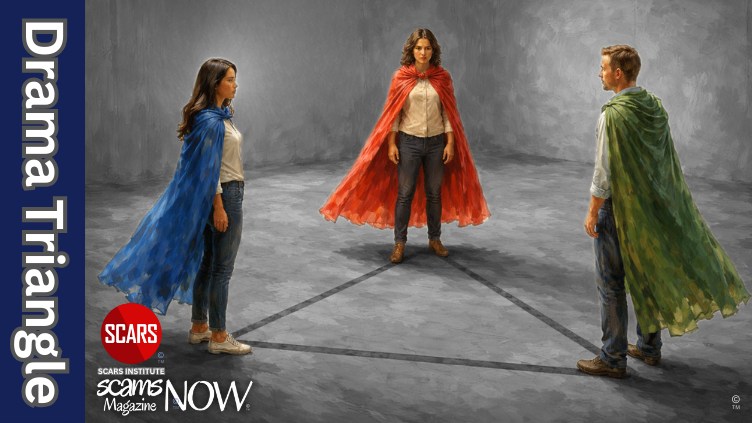






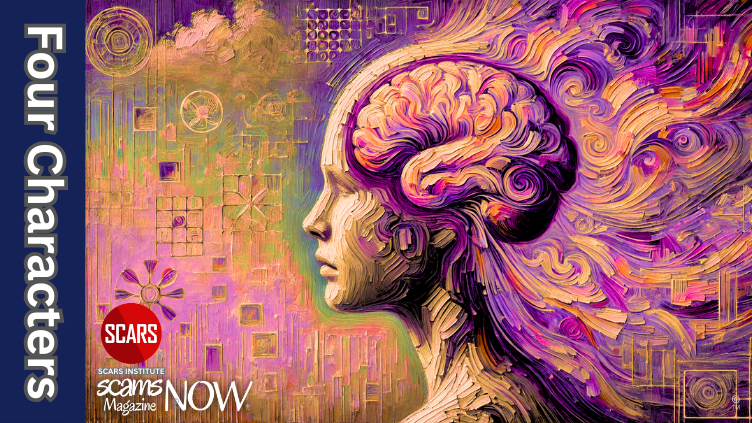
![NavyLogo@4x-81[1] The Uncanny Valley and Scams - A View of Scam Victims' Suspension of Disbelief - 2024](https://scamsnow.com/wp-content/uploads/2025/04/NavyLogo@4x-811.png)
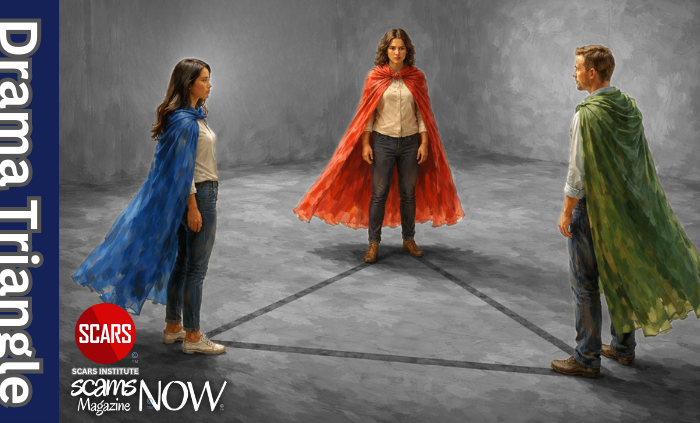


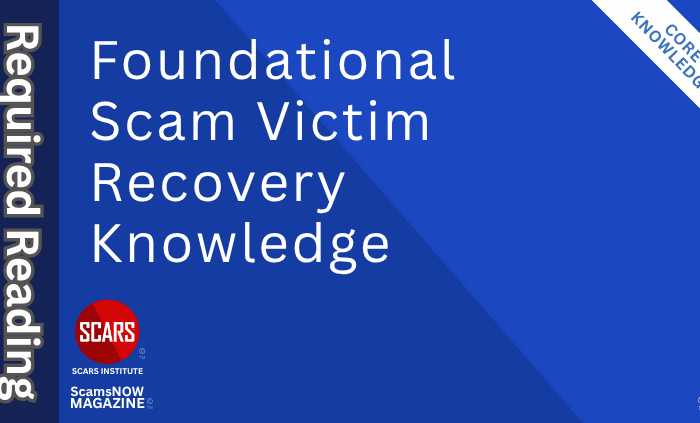




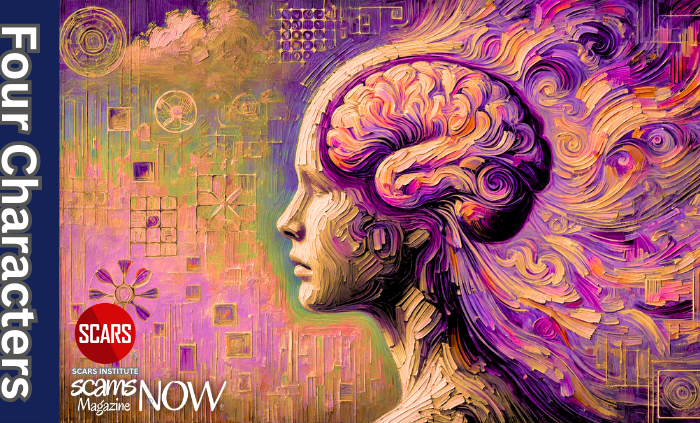
![scars-institute[1] The Uncanny Valley and Scams - A View of Scam Victims' Suspension of Disbelief - 2024](https://scamsnow.com/wp-content/uploads/2025/04/scars-institute1.png)
![niprc1.png1_-150×1501-1[1] The Uncanny Valley and Scams - A View of Scam Victims' Suspension of Disbelief - 2024](https://scamsnow.com/wp-content/uploads/2025/04/niprc1.png1_-150x1501-11.webp)
